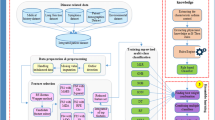Abstract
Asthma, a chronic disease, involves various clinico-epidemiological factors. In view of this, its early detection followed by management is required for providing better healthcare support to patients. This paper proposes an efficient machine learning methodology for the computerized detection of asthma that ensembles clinico-epidemiological and spirometric information to help pulmonologists in diagnostic decision-making. A total of 42 features (30 clinico-epidemiological and 12 spirometric parameters) are considered for diagnosing asthma. Statistical evaluation is employed to identify potential features for characterizing asthma. A pattern classification scheme based on three neural network models (probabilistic, radial basis function, and multilayer perceptron neural networks) and the alternating decision (AD) tree technique are investigated. Finally, the performance of the designed diagnostic scheme is evaluated in terms of sensitivity, specificity, and overall accuracy. 17 features are found to be statistically significant for discriminating two groups (asthma vs. healthy). Of the trained neural network models, the multilayer perceptron model has the highest accuracy (96.55 % sensitivity, 97.18 % specificity, and 96.86 % overall classification accuracy) for the automated classification of asthma-based statistically significant features. Moreover, the AD tree has a higher asthma screening accuracy (97.73 % sensitivity, 99.53 % specificity, and 99 % overall classification accuracy) than that of the multilayer perceptron model. The AD tree converges to the highest accuracy based on only seven features, which were selected iteratively and automatically.
Access this article
We’re sorry, something doesn't seem to be working properly.
Please try refreshing the page. If that doesn't work, please contact support so we can address the problem.






Similar content being viewed by others
References
A. L. Association, “Asthma,”. http://www.lung.org/assets/documents/publications/lung-disease-data/solddc_2010.pdf“.
Chae, Y. M., Ho, S. H., Hong, C. S., & Kim, C. W. (1996). Comparison of alternative knowledge model for the diagnosis of asthma. Expert Systems with Applications, 11, 423–429.
Choi, B. W., Yoo, K. H., Jeong, J. W., Yoon, H. J., Kim, S. H., Park, Y. M., et al. (2007). Easy diagnosis of asthma: computer-assisted, symptom-based diagnosis. Journal of Korean Medical Science, 22, 832–838.
Zolnoori, M., Zarandi, M. H. F., Moin, M., Heidarnezhad, H., & Kazemnejad, A. (2012). Computer-aided intelligent system for diagnosing pediatric asthma. Journal of Medical Systems, 36, 809–822.
Zarandi, M. F., Zolnoori, M., Moin, M., & Heidarnejad, H. (2010). A fuzzy rule-based expert system for diagnosing Asthma. Transaction E: Industrial Engineering, 17, 129–142.
Heris, T., Langarizadeh, M., Mahmoodvand, Z., & Zolnoori, M. (2013). Intelligent diagnosis of asthma using machine learning algorithms. International Research Journal of Applied and Basic Sciences, 5, 140–145.
Lee, K., Chin, N., & Lim, T. (2000). Asthma in the elderly-a more severe disease. Singapore Medical Journal, 41, 579–581.
Semic-Jusufagic, A., & Custovic, A. (2007). Active smoking among asthmatic youth—How concerned we need to be. International Journal of Chronic Obstructive Pulmonary Disease, 2, 3–4.
Burke, W., Fesinmeyer, M., Reed, K., Hampson, L., & Carlsten, C. (2003). Family history as a predictor of asthma risk. American Journal of Preventive Medicine, 24, 160–169.
Gong, J. H. (1990). Wheezing and Asthma. In W. D. H. H. Kenneth & J. Willis (Eds.), Clinical Methods: The History. Physical and Laboratory Examinations, Boston: Butterworth Publishers.
Kydd, R. M. (2010). Socioeconomic, environmental and personal correlates of asthma in a community population of men and women, University of Saskatchewan, Saskatchewan. Retrieved from http://hdl.handle.net/10388/etd-06192010-034006.
Gjevre, J. A., Hurst, T. S., Taylor-Gjevre, R. M., & Cockcroft, D. W. (2006). The American Thoracic Society’s spirometric criteria alone is inadequate in asthma diagnosis. Canadian Respiratory Journal, 13, 433–437.
Gun, A. M., Gupta, M. K., & Dasgupta, B. (2008). Fundamentals of statistics. Kolkata: The World Press.
Das, D. K., Chakraborty, C., Mitra, B., Maiti, A. K., & Ray, A. K. (2013). Quantitative microscopy approach for shape-based erythrocytes characterization in anaemia. Journal of Microscopy, 249, 136–149.
Chiu, C. H. (2009). Application of Back-propagation Neural network to categorization of physical fitness levels taiwanese females. Journal of Medical and Biological Engineering, 31, 31–35.
Duda, R. O., Hart, P. E., & Stork, D. G. (1999). Pattern classification. New York: Wiley.
Wang, S. L., Li, X., Zhang, S., Gui, J., & Huang, D. S. (2010). Tumor classification by combining PNN classifier ensemble with neighborhood rough set based gene reduction. Computers in Biology and Medicine, 40, 179–189.
Freund, Y. (2002) Alternating tree-based classifiers and methods for learning them, Google Patents.
Holmes, G., Pfahringer, B., Kirkby, R., Frank, E., & Hall, M. (2002). Multiclass alternating decision trees. In 13th European Conference on Machine Learning.
Freund, Y., & Mason, L. (1999). The alternating decision tree learning algorithm. Proceedings in ICML, 99, 124–133.
Chakraborty, C., Mitra, T., Mukherjee, A., & Ray, A. K. (2009). CAIDSA: Computer-aided intelligent diagnostic system for bronchial asthma. Expert Systems with Applications, 36, 4958–4966.
Burge, P., Pantin, C., Newton, D., Gannon, P., Bright, P., Belcher, J., et al. (1999). Development of an expert system for the interpretation of serial peak expiratory flow measurements in the diagnosis of occupational asthma. Occupational and Environmental Medicine, 56, 758–764.
Acknowledgments
The authors are extremely thankful to the Department of Science & Technology, Government of India, for providing financial support under the Fast Track Scheme for Young Scientists to carry out this research (Ref. No. IIT/SRIC/SMST/SAA/2010-2013/29).
Author information
Authors and Affiliations
Corresponding author
Rights and permissions
About this article
Cite this article
Das, D.K., Chakraborty, C. & Bhattacharya, P.S. Automated Screening Methodology for Asthma Diagnosis that Ensembles Clinical and Spirometric Information. J. Med. Biol. Eng. 36, 420–429 (2016). https://doi.org/10.1007/s40846-016-0137-9
Received:
Accepted:
Published:
Issue Date:
DOI: https://doi.org/10.1007/s40846-016-0137-9




